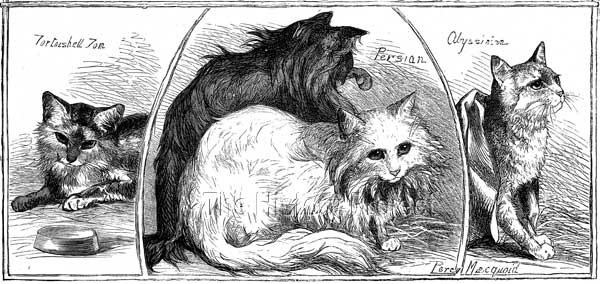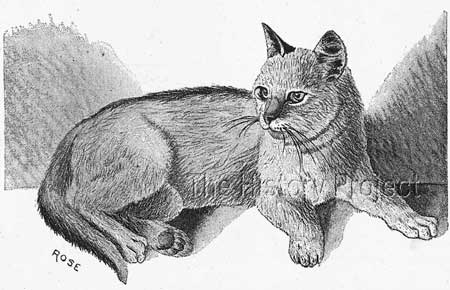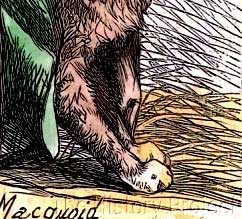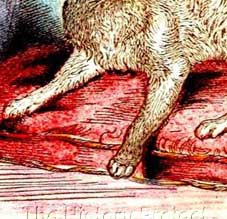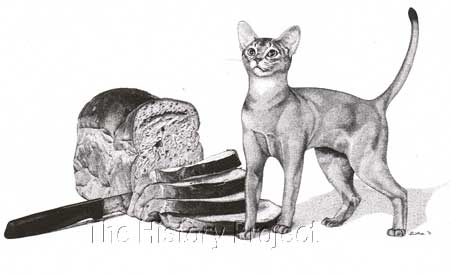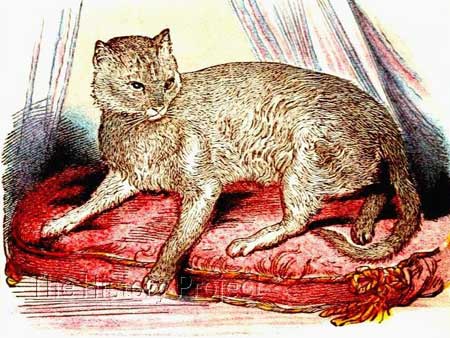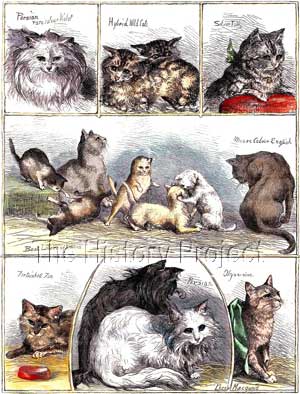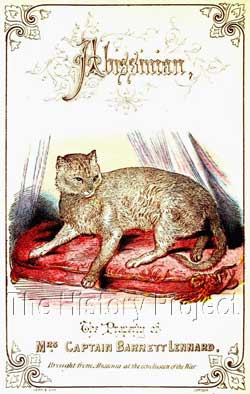 | ||||||||||||||||||||









|
ZULA (c1867)PHOTOS | SOCIAL MEDIA | REFERENCES
HISTORICAL BACKGROUND:The earliest record of a verifiable 'Abyssinian-born' domestic cat, also exhibited as a cat from Abyssinia and for which we have access to an illustration, is that of the little female 'Zula'. Her first public appearance was at Second National Cat Show held at The Crystal Palace, on 16th December, 1871. Although this may be the earliest written record of a cat imported from Abyssinia, that there were others which followed is evidenced by a commentary by Harrison Weir in his classic work Our Cats published 18 years later, in 1889. "Still, several have been imported from Abyssinia all of which were precisely similar, and it is stated that this is the origin of the Egyptian cat that was worshipped so many centuries ago."4 "It is mostly of a deep brown, ticked with black, somewhat resembling the back of a wild (only not so gray) rabbit. Along the centre of the back, from the nape of the neck to the tip of the tail, there is a band of black, very slightly interspersed with dark brown hairs. The inner sides of the legs and belly are more of a rufous-orange tint than the body, and are marked in some cases with a few dark patches; but they are best without these marks, and in the exhibition pens it is a point lost. The eyes are deep yellow, tinted with green; nose dark red, black-edged; ears rather small, dark brown, with black edges and tips; the pads of the feet are black. Altogether, it is a pretty and interesting variety."4 Harrison Weir's comments show his experience as a judge and his keen powers of observation. Already he has clearly identified traits that are distinctly 'Abyssinian'. The ticked coat pattern, the rufous undercoat, the dorsal stripe, the brick red nose-leather outlined in black, and the black pads to the paws. Similarly, he alludes to the 'Silver' variety, which he describes in the following terms: "I now refer to what is often called the silver tabby, for want of a better name. It is this. The whole of the ground colour is of a most delicate silver-gray, clear and firm in tone, slightly blue if anything apart from the gray, and the markings thereon are but a little darker, with a tinge of lilac in them making the fur to look like an evening sky, rayed with light clouds. The eyes are orange-yellow, and when large and full make a fine contrast to the colour of the fur. The nose is red, edged with a lilac tint, and the pads of the feet and claws are black, or nearly so. The hair is generally fine, short, and soft. Altogether it is most lovely, and well worthy of attention, forming as it does, a beautiful contrast to the red, the yellow, or even the brown tabby."4 We must remember that Harrison Weir was also one of the judges in attendance when 'Zula' made her appearance at The Crystal Palace Show in December 1871 and there is little doubt that he would have made a close personal observation of this first example of the 'Abyssinian' variety. The hand-coloured image by Percy Macquoid, published in the Supplement to Harper's Weekly in January 1872, was in fact a reprint, taken from The Graphic, originally published in London, on 16th December, 1871. The bottom portion of this page is shown below, with 'Zula' appearing at bottom right.
PARENTAGE & OWNERSHIP:
Unknown
Unknown
| Unknown
Zula (IMP), c1867, Ruddy Abyssinian, F
| Unknown
Unknown
Unknown
It is from Harrison Weir's long-time friend, Dr. Gordon Stables that we have details of Zula's ownership, and a second illustration of this cat in a relaxed pose from his book Cats: Their Points and Characteristics, published in 1874. In it we read that 'Zula' was the property of Mrs. Captain Barrett-Lennard, and was brought from Abyssinia at the conclusion of the war: "…..fed on the way home on raw beef, and was long very wild. She is now very fond of her mistress, but has a great many eccentricities which other cats have not, and is altogether a wonderful specimen of cat-kind."2 From the brief article in Harper's Weekly on the December 1871 Cat Show we find corroborative information and details of her show success: "The third prize was taken by the Abyssinian cat, shown in the lower right-hand corner of the illustration. She was captured in the late Abyssinian war, and was most remarkable for her woe-begone appearance, seemingly discontented at her sudden elevation into notoriety, and longing for her barbaric freedom in the good old days of King Theodore."1 So this confirms that 'Zula' was the first Abyssinian prize winner in a competitive environment. It also confirms that she is the first domestic cat to be described as an 'Abyssinian'. Given that the Abyssinian War ended in 1868, it also puts her date of birth, at the latest to around 1867, which means that by December 1871, she was probably at least 4 years old. In a second report on the same show, published in the Pall Mall Gazette, 2nd December, 1871, we find an alternative name and an individual trait for our Abyssinian cat! It reads: "…and there is the cat Light Zeyla, which was taken in Abyssinia by an English Officer during the late expedition, and which 'will drink from a tumbler or cup with its left paw'."8 SIBLINGS & SHOWS:Of course, there are no parental nor sibling records and 'Zula' was exhibited some 20 plus years before the formal registration of cats began. But that the breed continued to be appreciated by a few keen fanciers is borne out by a description written four years after Harrison Weir's jottings, by another judge, John Jennings, in his work Domestic and Fancy Cats, published by L. Upcott Gill in 1893: "THE ABYSSINIAN promises to increase in popularity, and whether imported or a manufactured cross hardly matters, as it now breeds fairly true to points. Certainly, no variety has yet rejoiced in such varied names, several countries claiming it as their own. In neither, however, can I find much approach to its type, so conclude that the art of crossing and selection has played no unimportant part in its propagation. Those who are familiar with the Belgian hare rabbit will have no difficulty in recognising the cat yclept Abyssinian. The fur throughout has for ground colour a rufous red, ticked with chocolate-black; ears, medium-sized and laced with black; and a narrow, well-defined stripe of black running longitudinally along the spine, and continuing to the extremity of the tail, is a feature of great importance in a good exhibition specimen. The eye varies colour, but a bright hazel is generally met with. In size, the Abyssinian resembles the self-coloured English cat. The coat should be very close and soft, the brighter the better, though some are weak in this respect."3
BREEDING & PROGENY:Although it is unlikely that we will know the true genetic origin of the ticked tabby pattern until historic dna profiling can be done for this breed, we do know that ticked tabby cats were extant in Egypt, in Abyssinia, and in India. Trade routes between the North-Western Indian states and the Gulf of Akaba could easily have brought the ticked tabby pattern from the Far East to the Middle-East, or vice-versa. It is also interesting to note that the problem of white, on chest or neck of some Abyssinians can likely be traced to some of the early imports from Abyssinia. If you carefully note both images of 'Zula' the lines in the drawings are strongly suggestive of at least one white paw; suggesting the presence of the white spotting factor, probably selectively bred out. The same was the case with white spotting in some early examples of Siamese.
Genetic flaws or imperfections can be dealt with by selection, line-breeding and reselection. But historians have only words and images to work with. For early images feline historians have only two choices, photographs if they exist, and if they do not, man-made illustrations, which are at best interpretative. The great difficulty for artists' attempting to render Abyssinian cats, is that to draw, indicate, or even moderately suggest, a ticked coat pattern is extremely difficult to do. It is, at best, only indicative. One of the best at presenting a ticked pattern in colour, was the great German draughtsman, Albrecht Durer, whose study of a Hare, produced in Watercolour in 1502, is a prime example. It is sad that Harrison Weir, who was undoubtedly one of the most successful and highly regarded animal artists of the Victorian era, did not leave us his own rendition/interpretation of an Abyssinian cat. He did however draw and paint many rabbits, so his written description can be relied upon. The writer's attempt to render a modern day Abyssinian cat, solely in black and white, suggesting the evenness of the ticked coat and at the same time, the musculature of the cat, using only two dimensions and the pointillist technique, is given below.
PHOTOS/ILLUSTRATIONS:
SOCIAL MEDIA :
In Summary: Whatever the historic case may be, selection can usually account for all of the successes in eliminating flaws and enhancing improvements within any breed. That the Abyssinian was the recipient of this same care is unquestioned. In the not too distant future, with the help of gene mapping and dna research, our scientists may be able to and recognise specific mark gene sequences within a breed, and then track the movement of gene pools between continents and between regions. Until then, we should defer to this very common-sense conclusion from the pen of Karen Lawrence, (CFA Judge and Historian) who wrote: "Ethiopia, a country historically known as Abyssinia, can thus logically be determined to be the source of the first acknowledged and recognised cat of the Abyssinian breed. "If we concede that Ethiopia is indeed the 'logical' origin of the Abyssinian breed, as we know it, it is not too far of a stretch to also believe numerous sources when they quote that the Abyssinian 'resembles the paintings and sculptures of ancient Egyptian cats'. The close proximity of the two countries - both in north-eastern Africa with early inhabitants belonging to nomadic tribes - could easily sustain a theory that the cats so revered in ancient Egypt migrated South to Ethiopia at some point, were taken to England and there became the basis of the Abyssinian breed. "In simple fact - we just don't know the origins of the Abyssinian breed and, while we can speculate as much as we want, we will probably never be able to accurately document the beginnings of the breed. Regardless of the proof in the theories put forth, or lack thereof, we recognise that the Abyssinian cats of today are stunning examples of the diligence of the early British breeders and it is they who have earned the credit for the beginnings and early evolution of the breed."7 'Zula' was the first cat from 'Abyssinia' to be exhibited in the United Kingdom and the prime forerunner of a unique and wonderful breed. The positive, inquisitive, loving and brightly versatile Abyssinian is revered today, by its admirers and adherents, as fervently as its relatives were in Ancient Egypt. Its similarity to the drawings of cats from out of that ancient land, remind us that this is a breed fit to live with, and receive, the admiration of the Gods. REFERENCES:
Registers associated with this article include The Incorporated Cat Fanciers Association of Great Britain (TICFAGB), National Cat Club (NCC), The Cat Club (CCR), Beresford Cat Club (BCC), Feline Federation Francaise (FFF), Siamese Cat Registry (SCR), US Register & Studbook for Cats (USR)including Supplement(USRS), The Studbook of the American Cat Association (ACA), and the Studbook & Register of the Cat Fanciers' Association (CFA).
|
|||||||||||||||||||
Home | Cats | Gallery | Clubs | People | Artifacts | Articles | Updates | Contact Us ©The CFA Foundation, Inc and The Harrison Weir Collection
|
||||||||||||||||||||

